
Mastering Irrigation: Optimal Techniques with Screen Filtration Systems & Fertilizer Injection Tanks
In the realm of agriculture and landscaping, efficiency and precision are crucial. Whether managing a vast farm or a meticulously landscaped garden, the effectiveness of the irrigation system can determine success. Two vital components in this regard are screen filtration systems and fertilizer injection tanks. When utilized effectively, they enhance productivity, conserve resources, and promote healthier plant growth. Let's delve into the best practices for integrating these elements into your irrigation setup for optimal outcomes.
Understanding Screen Filtration Systems
Screen filtration systems serve as the initial defense against debris, sediment, and contaminants that could clog irrigation lines and emitters. By capturing these particles, they maintain consistent water flow and pressure throughout the system. To maximize effectiveness:
- Appropriate Sizing: Ensure the mesh size of the screen filter matches your water source and the type of particles it carries. Finer meshes are suitable for smaller particles, while larger meshes suffice for less sediment-rich sources.
- Regular Maintenance: Schedule routine inspections and cleanings to prevent buildup and maintain filtration efficiency. Cleaning frequency depends on water quality, ranging from weekly to monthly.
- Backwashing: Incorporate a backwashing mechanism to flush out accumulated debris, extending the filter's lifespan and reducing manual cleaning frequency.
- Pressure Differential Monitoring: Install pressure gauges before and after the filter to monitor pressure differentials. Significant increases indicate potential clogging and signal the need for immediate attention.
Enhancing Efficiency with Fertilizer Injection Tanks
Fertilizer injection tanks offer a precise method of supplementing irrigation water with essential nutrients. By delivering fertilizers directly into the irrigation system, you ensure uniform distribution and minimize waste. Optimize their performance with these tips:
- Calibration: Accurate calibration of the injection system is crucial for precise nutrient delivery. Follow manufacturer guidelines and conduct periodic checks to verify dosage rates.
- Quality Fertilizers: Choose high-quality, water-soluble fertilizers that dissolve easily and are compatible with your irrigation system. Regularly inspect fertilizer stocks for impurities or clumping that could disrupt injection.
- Timing & Frequency: Tailor fertilization schedules to match crop or plant needs, considering factors such as growth stage, soil nutrient levels, and environmental conditions.
- Mixing & Dilution: Properly mix fertilizers with irrigation water to ensure uniform distribution and prevent equipment clogging. Use a dedicated mixing tank or injector for consistent concentrations.
By integrating screen filtration systems and fertilizer injection tanks into your irrigation setup, you can significantly enhance efficiency, productivity, and plant health. Adhering to best practices such as proper sizing, regular maintenance, accurate calibration, and strategic fertilization ensures optimal outcomes in agricultural or landscaping endeavors. Embrace these techniques, and witness your crops thrive and landscapes flourish.
